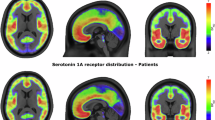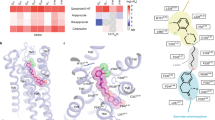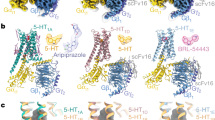Abstract
Changes in 5-HT1A receptor function or sensitivity following chronic antidepressant treatment may involve changes in receptor-G protein interaction. We have examined the effect of chronic administration of the SSRI fluoxetine or the tricyclic antidepressant amitriptyline on 5-HT1A receptor-stimulated [35S]GTPγS binding in serotonergic cell body areas, and cortical and limbic structures using quantitative autoradiography. Treatment of rats with fluoxetine, but not amitriptyline, resulted in an attenuation of 5-HT1A receptor-stimulated [35S]GTPγS binding in the dorsal and median raphe nuclei. The binding of the antagonist radioligand [3H]MPPF to 5-HT1A receptor sites was not altered, suggesting that the observed changes in 5-HT1A receptor-stimulated [35S]GTPγS binding were not due to changes in receptor number. Thus, the desensitization of somatodendritic 5-HT1A autoreceptors in the dorsal and median raphe following chronic SSRI treatment appears to be due to a reduced capacity of the 5-HT1A receptor to activate G protein. By contrast, no significant change in postsynaptic 5-HT1A receptor-stimulated [35S]GTPγS binding was observed in any of the forebrain areas examined following chronic antidepressant treatment. Thus, changes in postsynaptic 5-HT1A receptor-mediated responses reported to follow chronic SSRI or tricyclic antidepressant administration most likely occur distal to receptor-G protein interaction, perhaps at the level of effector, or involving changes in neuronal function at the system or circuit level.
Similar content being viewed by others
Log in or create a free account to read this content
Gain free access to this article, as well as selected content from this journal and more on nature.com
or
References
Barr AJ, Brass LF, Manning DR . (1997): Reconstitution of receptors and GTP-binding regulatory proteins (G proteins) in Sf9 cells. A direct evaluation of selectivity in receptor-G protein coupling. J Biol Chem 272: 2223–2229
Blier B, de Montigny C . (1983): Electrophysiological investigations on the effect of repeated zimelidine administration on serotonergic neurotransmission in the rat. J Neurosci 3: 1270–1278
Blier P, de Montigny C . (1980): Effect of chronic tricyclic antidepressant treatment on the serotonergic autoreceptor. Naunyn-Schmiedeberg's Arch Pharmacol 314: 123–128
Blier P, de Montigny C . (1994): Current advances and trends in the treatment of depression. Trends Pharmacol Sci 15: 220–226
Bosker FJ, Cremers TIFH, Jongsma ME, Westerink BHC, Wikstrom HB, den Boer JA . (2001): Acute and chronic effects of citalopram on postsynaptic 5-hydroxytrptamine1A receptor-mediated feedback: a microdialysis study in the amygdala. J Neurochem 76: 1645–1653
Bosker FJ, Klompmakers AA, Westenberg HGM . (1997): Postsynaptic 5-HT1A receptors mediate 5-hydroxytryptamine release in the amygdala through a feedback to the caudal linear raphe. Eur J Pharmacol 333: 147–157
Casanovas JM, Hervas I, Artigas F . (1999): Postsynaptic 5-HT1A receptors control 5-HT release in the rat medial prefrontal cortex. Neuroreport 10: 1441–1445
Ceci A, Baschirotto A, Borsini F . (1994): The inhibitory effect of 8-OH-DPAT on the firing activity of dorsal raphe serotoninergic neurons in rats is attenuated by lesion of the frontal cortex. Neuropharmacology 33: 709–713
Chaput Y, de Montigny C, Blier P . (1986): Effects of a selective 5-HT reuptake blocker, citalopram, on the sensitivity of 5-HT autoreceptors: Electrophysiological studies in the rat brain. Naunyn-Schmiedebergs Arch Pharmacol 333: 342–348
Chaput Y, de Montigny C, Blier P . (1991): Presynaptic and postsynpatic modifications of the serotonin system by long-term administration of antidepressant treatments. Neuropsychopharmacology 5: 219–229
Clarke WP, Berg KA, Gould G, Frazer A . (2001): Serotonin receptor binding. In Enna SJ (ed), Current Protocols in Pharmacology. New York, Wiley, pp 1.23.1–1.23.33
Czachura JF, Rasmussen K . (2000): Effects of acute and chronic administration of fluoxetine on the activity of serotonergic neurons in the dorsal raphe nucleus of the rat. Naunyn-Schmiedeberg's Arch Pharmacol 362: 266–275
de Montigny C, Aghajanian GK . (1978): Tricyclic antidepressants: Long-term treatment increases responsivity of rat forebrain neurons to serotonin. Science 22: 1303–1306
Fabre V, Beaufour C, Evrard A, Rioux A, Hanoun N, Lesch KP, Murphy DL, Lanfumey L, Hamon M, Martres M-P . (2000a): Altered expression and functions of serotonin 5-HT1A and 5-HT1B receptors in knock-out mice lacking the 5-HT transporter. Eur J Neurosci 12: 229–2310
Fabre V, Boutrel B, Hanoun N, Lanfumey L, Fattaccini CM, Demeneix B, Adrien J, Hamon M, Martres M-P . (2000b): Homeostatic regulation of serotonergic function by the serotonin transporter as revealed by nonviral gene transfer. J Neurosci 20: 5065–5075
Gallager DW, Bunney WE . (1978): Failure of chronic lithium treatment to block tricyclic antidepressant-induced 5-HT supersensitivity. Naunyn-Schmiedeberg's Arch Pharmacol 307: 129–133
Gartside SE, Umbers V, Sharp T . (1992): Inhibition of 5-HT cell firing in the DRN by non-selective 5-HT reuptake inhibitors: studies on the role of 5–HT1A autoreceptors and noradrenergic mechanisms. Psychopharmacology 130: 261–268
Geary WAD, Toga AW, Wooten GF . (1985): Quantitative film autoradiography for tritium: methodological considerations. Brain Res 337: 99–108
Geary WAD, Wooten GF . (1983): Quantitative film autoradiography of opiate agonist and antagonist binding in rat brain. J Pharmacol Exp Ther 225: 234–240
Goodwin GM, de Souza RJ, Green AR . (1987): Attenuation by electroconvulsive shock and antidepressant drugs of the 5–HT1A receptor-mediated hypothermia and serotonin syndrome produced by 8-OH-DPAT in the rat. Psychopharmacology 91: 500–505
Hensler JG, Durgam H . (2001): Regulation of 5-HT1A receptor-stimulated [35S]GTPγS binding as measured by quantitative autoradiography following chronic agonist administration. Br J Pharmacol 132: 605–611
Hensler JG, Kovachich GB, Frazer A . (1991): A quantitative autoradiographic study of serotonin1A receptor regulation: Effect of 5,7-dihydroxytryptamine and antidepressant treatments. Neuropsychopharmacology 4: 131–144
Hervàs I, Vilaro MT, Romero L, Scorza MC, Mengod G, Artigas F . (2001): Desensitization of 5–HT1A autoreceptors by a low chronic fluoxetine dose. Effect of the concurrent administration of WAY-100,635. Neuropsychopharmacology 24: 11–20
Kreiss DS, Lucki I . (1995): Effects of acute and repeated administration of antidepressant drugs on extracellular levels of 5-hydroxytryptamine. J Pharmacol Exp Ther 274: 866–867
Le Poul E, Boni C, Hanoun N, Laporte AM, Laaris N, Chauveau J, Hamon M, Lanfumey L . (2000): Differential adaption of brain 5–HT1A and 5–HT1B receptors and 5-HT transporter in rats treated chronically with fluoxetine. Neuropharmacology 39: 110–122
Lerer BE, Gelfin Y, Grofine M, Allolio B, Lesch KP, Newman ME . (1999): 5–HT1A receptor function in normal subjects on clinical doses of fluoxetine: blunted temperature and hormone responses to ipsapirone challenge. Neuropsychopharmacology 20: 628–639
Lesch KP, Aulakh CS, Tolliver TJ, Hill JL, Murphy DL . (1991): Regulation of G proteins by chronic antidepressant drug treatment in rat brain: tricyclics but not clorgyline increase Goα. Eur J Pharmacol Mol Pharmacol 207: 361–364
Lesch KP, Disselkapm-Tietze J, Schmidtke A . (1990): 5–HT1A receptor function in depression: effect of chronic amitriptyline treatment. J Neural Transm Gen Sect 80: 157–161
Li Q, Muma NA, Van de Kar LD . (1996): Chronic fluoxetine induces a gradual desensitization of 5-HT1A receptors: reductions in hypothalamic and midbrain Gi and Go proteins and in neuroendocrine responses to a 5-HT1A agonist. J Pharmacol Exp Ther 279: 1035–1042
Lohse MJ . (1993): Molecular mechanisms of membrane receptor desensitization. Biochimica et Biophysica Acta. 1179: 171–188
Lucki I, Frazer A . (1982): Prevention of the serotonin syndrome in rats by repeated administration of monoamine oxidase inhibitors but not tricyclic antidepressants. Psychopharmacology 77: 205–211
Meller E, Li H, Carr KD, Hiller JM . (2000): 5-Hydroxytryptamine(1A) receptor-stimulated [(35)S]GTPgammaS binding in rat brain: absence of regional differences in coupling efficiency. J Pharmacol Exp Ther 292: 684–691
Newman ME, Shapira B, Lerer B . (1992): Regulation of 5-hydroxytryptamine1A receptor function in rat hippocampus by short- and long-term administration of 5-hydroxytryptamine1A agonists and antidepressants. J Pharmacol Exp Ther 260: 16–20
Paxinos G, Watson C . (1986): The Rat Brain in Stereotaxic Coordinates. New York, Academic Press
Raap DK, Evans S, Garcia F, Li Q, Muma NA, Wolf WA, Battaglia G, Van de Kar LD . (1999): Daily injections of fluoxetine induce dose-dependent desensitization of hypothalamic 5–HT1A receptors: reductions in neuroendocrine responses to 8-OH-DPAT and in levels of Gz and Gi proteins. J Pharmacol Exp Ther 288: 98–106
Raymond JR, Olsen CL, Gettys TW . (1993): Cell-specific physical and functional coupling of human 5-HT1A receptors to inhibitory G protein α-subunits and lack of coupling to Gsα. Biochemistry 32: 11064–11073
Serres F, Li Q, Garcia F, Raap DK, Battaglia G, Muma NA, Van de Kar LD . (2000): Evidence that Gz-proteins couple to hypothalamic 5–HT1A receptors in vivo. J Neurosci 20: 3095–3103
Sim LJ, Xiao R, Childers SR . (1997): In vitro autoradiographic localization of 5–HT1A receptor-activated G proteins in the rat brain. Brain Res Bulletin 44: 39–45
Varrault A, Leviel V, Bockaert J . (1991): 5-HT1A-sensitive adenylyl cyclase of rodent hippocampal neurons: Effects of antidepressant treatments and chronic stimulation with agonists. J Pharmacol Exp Ther 257: 433–438
Waeber C, Moskowitz MA . (1997): 5-Hydroxytryptamine1A and 5-hydroxytryptamine1B receptors stimulate [35S]guanosine-5′-O-(3-thio)triphosphate binding to rodent brain sections as visualized by in vitro autoradiography. Mol Pharmacol 52: 623–631
Welner SA, de Montigny C, Desroches J, Desjardins P, Suranyi-Cadotte BE . (1989): Autoradiographic quantification of serotonin1A receptors in rat brain following antidepressant drug treatment. Synapse 4: 347–352
Wieland S, Fischette CT, Lucki I . (1993): Effect of chronic treatments with tandospirone and imipramine on serotonin-mediated behavioral responses and monoamine receptors. Neuropharmacology 32: 561–573
Wozniak KM, Aulakh CS, Hill JL, Murphy DL . (1987): The effect of 8-OH-DPAT on temperature in the rat and its modification by chronic antidepressant treatments. Pharmacol Biochem Behav 30: 451–456
Yamada K, Nagayama H, Tsuchiyama K, Akiyoshi J . (1994): The effect of chronic administration of antidepressants and electroconvulsive shock on the 5–HT1A receptor mediated hypothermic response induced by 8-OH-DPAT in the rat. Prog Neuropsychopharmacol Biol Psychiatry 18: 409–416
Acknowledgements
The author gratefully acknowledges Ms. Teri Frosto for excellent technical support and would like to thank Dr. David Morilak for helpful discussions. This research was supported by US PHS grant MH 52369 and funds from the South Texas Health Research Center.
Author information
Authors and Affiliations
Corresponding author
Rights and permissions
About this article
Cite this article
Hensler, J. Differential Regulation of 5-HT1A Receptor-G Protein Interactions in Brain Following Chronic Antidepressant Administration. Neuropsychopharmacol 26, 565–573 (2002). https://doi.org/10.1016/S0893-133X(01)00395-5
Received:
Revised:
Accepted:
Published:
Issue date:
DOI: https://doi.org/10.1016/S0893-133X(01)00395-5
Keywords
This article is cited by
-
Evaluation of neurobehavioral activities of ethanolic extract of Psidium guajava Linn leaves in mice model
Future Journal of Pharmaceutical Sciences (2021)
-
CODA-ML: context-specific biological knowledge representation for systemic physiology analysis
BMC Bioinformatics (2019)
-
New arylpiperazine derivatives with antidepressant-like activity containing isonicotinic and picolinic nuclei: evidence for serotonergic system involvement
Naunyn-Schmiedeberg's Archives of Pharmacology (2019)
-
A Shift in the Activation of Serotonergic and Non-serotonergic Neurons in the Dorsal Raphe Lateral Wings Subnucleus Underlies the Panicolytic-Like Effect of Fluoxetine in Rats
Molecular Neurobiology (2019)
-
Blunted 5-HT1A receptor-mediated responses and antidepressant-like behavior in mice lacking the GABAB1a but not GABAB1b subunit isoforms
Psychopharmacology (2017)



